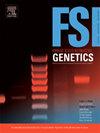由Ryanodine受体2型引起的危及生命的心律失常的非青少年家族型G>A, p.(Arg4608Gln)致病变异:非典型儿茶酚胺能多态性室性心动过速或误诊?
IF 3.1
2区 医学
Q2 GENETICS & HEREDITY
引用次数: 0
摘要
儿茶酚胺能多形性室性心动过速(CPVT)是一种罕见的遗传性通道病,可导致潜在致命的恶性心律失常发作。非典型非幼年型CPVT可能不会误导钙释放缺乏症(CRDS)的替代诊断。主要病例是一名58岁的妇女,她经历了流产的心脏骤停。最初的完整诊断检查(包括去甲肾上腺素激发)完全阴性。她被植入了完全皮下的除颤器。在随访期间,她接受了适当的电击(心室颤动),尽管有β受体阻滞剂治疗。3名姐妹(46岁、40岁和18岁)以及2名表兄妹、1名叔父和1名舅母均有家族史中无病因的心源性猝死(SCD)。在家庭成员中没有其他怀孕失败、新生儿死亡、癫痫发作或SCD的报告。该先证者的遗传分析显示,在RYR2基因中存在一个错义致病变异c.13823 G> a, p.(Arg4608Gln),编码Ryanodine受体2型。这个c.13823 G>;A, p.(Arg4608Gln)的RYR2基因变异被认为是CPVT的潜在致病变异。不幸的是,在先证者的基因分析结束之前,她20岁的女儿经历了SCD,同时植入了一个可插入的心脏监测器。家族分离分析证实4名有症状的姐妹也携带相同的变异,证实了该变异的致病作用。我们还确定了7名下一代临床CPVT阴性的携带者。所有患者均给予纳多洛尔80 mg /天治疗,24个月后随访无明显变化。结论Ryanodine受体2型 c.13823 G>;A, p.(Arg4608Gln)致病性变异在恶性家族型CRDS中被描述。本文章由计算机程序翻译,如有差异,请以英文原文为准。
Non-juvenile familial form of life-threatening arrhythmias caused by the Ryanodine Receptor type 2 c.13823 G>A, p.(Arg4608Gln) pathogenic variant: Atypical catecholaminergic polymorphic ventricular Tachycardia or misdiagnosis?
Background
Catecholaminergic Polymorphic Ventricular Tachycardia (CPVT) is a rare inherited channelopathy, responsible for potentially lethal malignant arrhythmic episodes. Atypical non-juvenile form of CPVT may not mislead an alternative diagnosis of calcium release deficiency syndrome (CRDS).
Case
The index case was a 58 years-old woman who experienced aborted sudden cardiac arrest. The initial complete diagnostic workup (including norepinephrine challenge) was completely negative. She was implanted with an entirely subcutaneous defibrillator. During her follow-up, she received an appropriate electrical shock (ventricular fibrillation) despite β-blocker treatment. Three sisters (46, 40 and 18 years-old) as well as 2 cousins, one paternal uncle and one paternal aunt had sudden cardiac deaths (SCD) without etiology in the family history. There were no additional reports of pregnancy loss, neonatal death, seizures or SCD among the family members. The genetic analysis in this proband revealed a missense pathogenic variant c.13823 G>A, p.(Arg4608Gln) in the RYR2 gene, encoding the Ryanodine Receptor type 2. This c.13823 G>A, p.(Arg4608Gln), variant in the RYR2 gene was supposed to be a potential disease-causing variant in CPVT. Unfortunately, before the end of the proband's genetic analysis, her 20 years-old daughter experienced SCD, whilst being implanted with an insertable cardiac monitor. Familial segregation analysis confirmed the four symptomatic sisters harbor also the same variant confirming the pathogenic role of this variant. We also identified 7 carriers who were clinically negative for CPVT in the next generation. Whole were treated with Nadolol 80 mg per day, and the follow-up was uneventful after twenty-four months.
Conclusion
The Ryanodine Receptor type 2 c.13823 G>A, p.(Arg4608Gln) pathogenic variant is described in a malignant familial form of CRDS.
求助全文
通过发布文献求助,成功后即可免费获取论文全文。
去求助
来源期刊
CiteScore
7.50
自引率
32.30%
发文量
132
审稿时长
11.3 weeks
期刊介绍:
Forensic Science International: Genetics is the premier journal in the field of Forensic Genetics. This branch of Forensic Science can be defined as the application of genetics to human and non-human material (in the sense of a science with the purpose of studying inherited characteristics for the analysis of inter- and intra-specific variations in populations) for the resolution of legal conflicts.
The scope of the journal includes:
Forensic applications of human polymorphism.
Testing of paternity and other family relationships, immigration cases, typing of biological stains and tissues from criminal casework, identification of human remains by DNA testing methodologies.
Description of human polymorphisms of forensic interest, with special interest in DNA polymorphisms.
Autosomal DNA polymorphisms, mini- and microsatellites (or short tandem repeats, STRs), single nucleotide polymorphisms (SNPs), X and Y chromosome polymorphisms, mtDNA polymorphisms, and any other type of DNA variation with potential forensic applications.
Non-human DNA polymorphisms for crime scene investigation.
Population genetics of human polymorphisms of forensic interest.
Population data, especially from DNA polymorphisms of interest for the solution of forensic problems.
DNA typing methodologies and strategies.
Biostatistical methods in forensic genetics.
Evaluation of DNA evidence in forensic problems (such as paternity or immigration cases, criminal casework, identification), classical and new statistical approaches.
Standards in forensic genetics.
Recommendations of regulatory bodies concerning methods, markers, interpretation or strategies or proposals for procedural or technical standards.
Quality control.
Quality control and quality assurance strategies, proficiency testing for DNA typing methodologies.
Criminal DNA databases.
Technical, legal and statistical issues.
General ethical and legal issues related to forensic genetics.

 求助内容:
求助内容: 应助结果提醒方式:
应助结果提醒方式:


